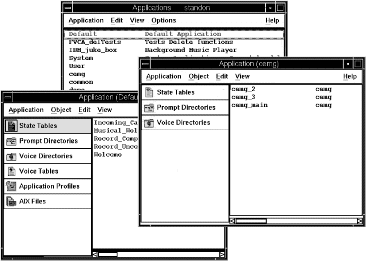The application is a “container” of application objects, which means that each object must be specified in one, and only one, application. In addition, each object must have a unique name, within that type of object, across all applications.
It is very likely that some objects will be useful in more than one voice response service: for example, voice segments for commonly-used phrases. Copying them has two disadvantages: storage is used unnecessarily and you have to rename each copy. Instead of copying, you can make an object available to be used by more than one application, by putting it into a common application.A common application is just an ordinary application whose objects are to be used by more than one other application.
You then add the common application to the list of application prerequisites for any application that is to use it. When you export any of these applications, the system gives you the opportunity to export the common application at the same time.
For example, the cemg application in Figure 1 includes all the state tables, and the specific prompts, voice segments, and voice tables used by those state tables; while the common application includes prompts, voice segments, and voice tables that might be used by other applications too.
